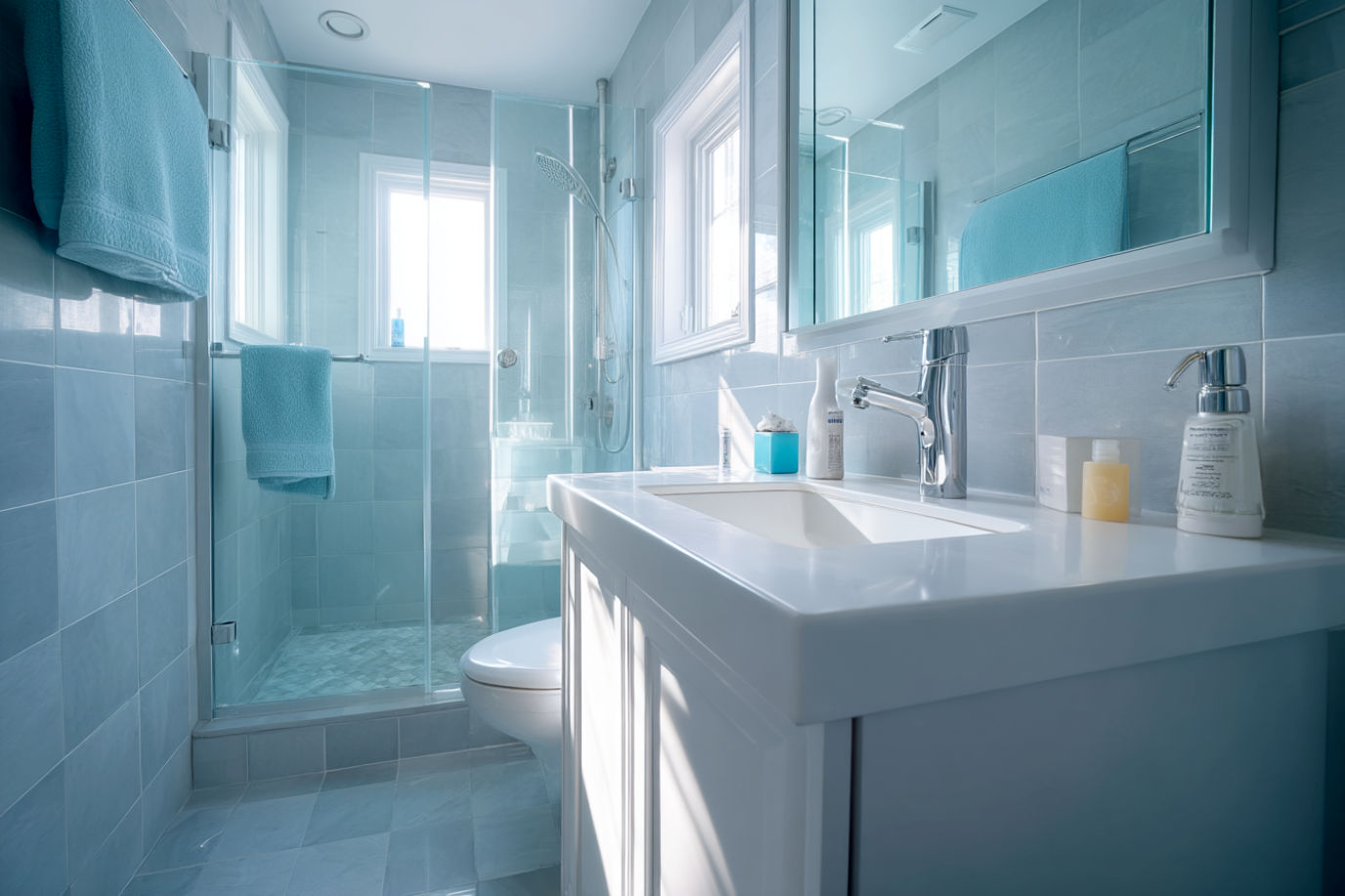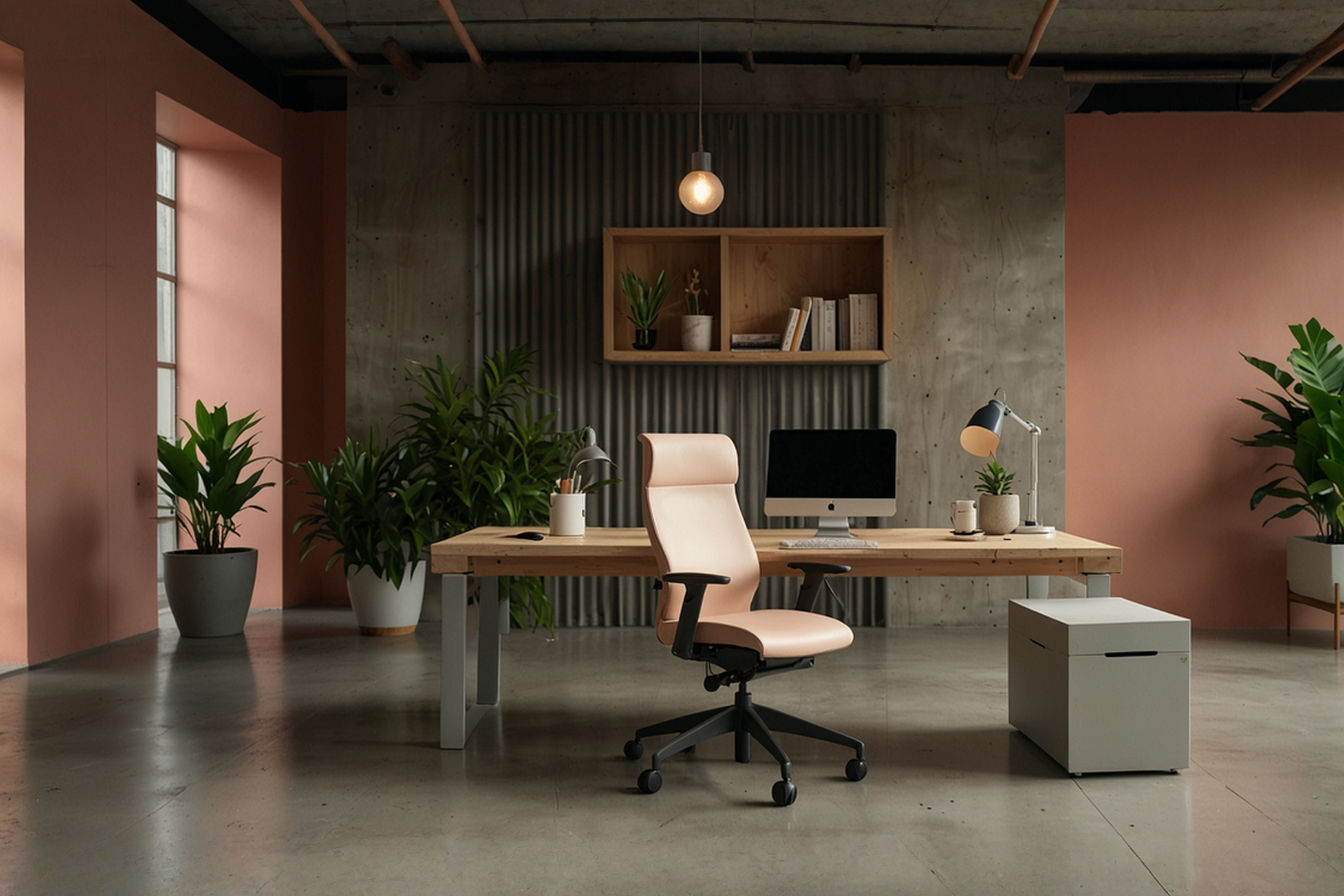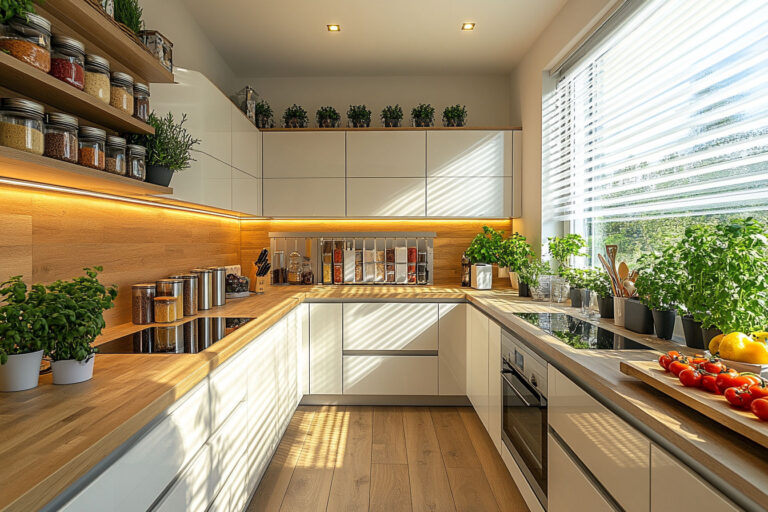This post may contain affiliate links. If you make a purchase through these links, we may earn a commission at no additional cost to you.
Living in a compact home doesn’t mean sacrificing your love for technology. In today’s connected world, most of us own multiple devices—smartphones, tablets, laptops, headphones, chargers, and various other electronic gadgets that quickly create clutter in small living spaces. Finding storage solutions that keep these essential items accessible yet organized can transform your living experience.
The challenge goes beyond simply finding places to stash your tech. Effective tech storage balances accessibility, protection, and aesthetics while navigating the constraints of limited square footage. Proper organization not only enhances your space visually but also extends the lifespan of your valuable electronics by reducing the risk of damage.
This comprehensive guide explores innovative solutions that maximize your available space while keeping your devices protected and ready to use. Whether you’re dealing with a tiny apartment, studio living, or simply trying to minimize tech clutter in your home, these smart storage ideas offer practical approaches for every room and budget.
By implementing even a few of these strategies, you’ll transform tangled cables and scattered gadgets into an organized system that makes your small space feel more spacious and serene. Let’s explore solutions that prove you don’t need abundant space to maintain a harmonious relationship with your technology.
1. Vertical Wall-Mounted Solutions
When floor space is at a premium, looking upward provides untapped storage potential. Vertical storage utilizes wall space that often goes unused in small homes, keeping your tech accessible without consuming valuable surface areas.
Wall-mounted charging stations offer an elegant solution for everyday devices. These purpose-built shelves include integrated power management, creating dedicated spots for phones and tablets while they charge. Many models feature built-in USB ports and outlets that minimize cord clutter. Choose options with additional hooks or small compartments for headphones and smartwatches to maximize functionality.
Floating shelves designed specifically for electronics provide stable platforms while incorporating clever features like hidden cable channels or built-in power strips. Position these near seating areas for convenient access to frequently used devices. Some innovative designs include sliding or flip-down components that conceal electronics when not in use, instantly transforming your tech station into decorative shelving.
Pegboard systems have evolved beyond workshop organization to offer remarkable flexibility for tech storage. Modern pegboards with specialized hooks and attachments can secure everything from tablets to cables in customizable arrangements. Their adaptability allows you to reconfigure your storage as your device collection evolves—simply move the hooks and accessories to create new layouts without drilling additional holes in your walls.
For smaller accessories and charging cables, fabric wall pockets and mesh organizers mounted at convenient heights keep items visible yet contained. These soft-sided solutions prevent scratches on delicate electronics while maintaining easy access to items you need regularly.
The primary advantage of vertical solutions lies in their ability to keep technology elevated and protected from spills, pets, and accidental damage while freeing up valuable surface space for other activities.
2. Hidden and Dual-Purpose Storage
For those who prefer their technology to remain discreet when not in use, hidden storage solutions maintain a clean aesthetic while keeping devices accessible. This approach is particularly valuable in multifunctional spaces like studio apartments.
Furniture with hidden compartments offers perhaps the most elegant solution. Modern ottomans, coffee tables, and side tables often feature concealed storage perfect for tablets, laptops, and gaming controllers. Some innovative designs include dedicated cable management systems and even built-in charging capabilities, allowing devices to power up while remaining out of sight.
Picture frame storage provides a clever disguise for small electronics. Wall-mounted frame units with hinged fronts open to reveal shallow storage compartments perfect for tablets, e-readers, or remote controls. When closed, they display artwork or photos, completely concealing their practical purpose.
Hollow book storage offers a charming solution for bibliophiles. These decorative boxes resemble hardcover books but open to reveal spaces perfect for storing compact tech like smartphones, earbuds, or portable chargers. Placed among real books on a shelf, they maintain a clutter-free appearance while keeping small devices accessible.
Under-sofa sliding drawers make excellent use of often-overlooked space. Shallow drawers that pull out from beneath furniture provide perfect storage for laptops, tablets, or gaming accessories. Some specialized products feature built-in charging ports, allowing devices to power up in their hidden location.
The psychological benefit of concealed tech storage extends beyond practical organization. Hiding visual technology cues creates a more restful environment that can help separate work and leisure time—particularly important in small homes where spaces serve multiple purposes.
3. Smart Cable Management Systems
Nothing creates visual chaos faster than tangled charging cables and power cords. Effective cable management systems transform unsightly wire clusters into ordered arrangements that protect your devices and enhance your space.
Cable organizers range from simple adhesive clips to elaborate channeling systems. Adhesive cable clips mounted to desks, nightstands, or walls keep individual charging cables accessible without allowing them to slide out of reach when disconnected. For multiple cables, desktop cable management boxes conceal power strips and excess cord length inside attractive containers with small openings for the portions you actively use.
For floor-bound cables like those connecting entertainment systems, cord covers that match your wall color create a more streamlined appearance. These simple channels adhere to walls or baseboards, concealing cords inside paintable covers that blend with your decor. Some systems include corner pieces for a professional installation look without requiring construction skills.
Magnetic cable organizers offer a particularly elegant solution for charging areas. These small magnetic pieces attach to the end of your charging cables, then adhere to metal surfaces (or included metal plates) when not in use. This approach keeps cables neatly positioned and instantly available when needed, eliminating the familiar ritual of fishing for fallen cables behind furniture.
Under-desk cable management trays mount to the underside of work surfaces to keep power strips and excess cord length completely out of sight. These simple installations dramatically transform home office spaces by eliminating cord tangles that can interfere with leg room and create visual distraction.
Beyond aesthetics, proper cable management prevents premature wear on charging ports and cables. Organized cables experience less physical stress and strain, extending their lifespan and protecting your devices from connection issues caused by damaged wires.
4. Compact Charging Stations
Consolidating your charging needs into dedicated stations prevents device sprawl and simplifies your daily routine. Centralized charging areas streamline your tech maintenance while reducing the electrical hazards associated with overloaded outlets.
Multi-device charging docks accommodate several devices in upright positions, maximizing vertical space while minimizing footprint. The best options include dividers that prevent devices from touching and scratching one another. Look for models with integrated cable management that keeps each cord neatly organized and prevents tangling when devices are removed or replaced.
Wireless charging furniture has revolutionized how we power our compatible devices. Tables, lamps, and nightstands with built-in wireless charging pads eliminate cable clutter entirely for supported devices. Simply place your smartphone or wireless earbuds case on the designated spot to begin charging—no plugging or unplugging required. Some innovative options even disguise the charging area within natural materials like wood or stone for a seamless look.
DIY charging stations created from everyday items offer budget-friendly alternatives to commercial products. Simple letter holders, utensil organizers, or modified bookshelves can transform into effective charging stations with minor modifications. The key elements include divided spaces for different devices and strategic holes that allow charging cables to route cleanly from a hidden power source to each device’s position.
Hidden outlet solutions prevent charging areas from dominating your space. Furniture with built-in power supplies, outlets concealed within drawers, or decorative boxes with rear cord access allow you to power devices without the industrial appearance of exposed surge protectors and wall adapters.
The efficiency gained through centralized charging extends beyond organization. Dedicated charging zones reduce the risk of forgotten devices and establish consistent habits that ensure your tech is powered up and ready when needed.
5. Tech-Friendly Furniture Solutions
Manufacturers increasingly recognize the need for furniture that accommodates our digital lifestyle. Investing in tech-integrated furniture eliminates retrofitting challenges and provides seamless solutions for small spaces.
Nightstands featuring built-in wireless charging surfaces or discreet power ports transform your bedside tech experience. These thoughtful designs maintain the traditional function of bedside storage while eliminating the need for exposed chargers and adapters. Models with additional cable management features prevent charging cords from becoming tangled with other bedside items.
Smart coffee tables serve as both practical surfaces and tech hubs. Modern designs include features like wireless charging zones, hidden storage compartments sized for tablets or laptops, and integrated cable management systems. Some models even incorporate pop-up charging stations that emerge when needed and conceal completely when entertaining.
TV stands with comprehensive organization tackle the substantial challenge of entertainment system cables and components. Look for designs with ventilated media cabinets, pass-through cable management, and adjustable shelving that accommodates changing technology sizes. Specialized compartments for gaming consoles, streaming devices, and remotes keep these items accessible but organized.
Desks with integrated technology solutions offer the most sophisticated approach for home office equipment. Features like built-in charging stations, grommet holes for cable passage, privacy panels with cord management, and monitor arms that attach directly to the desk structure create exceptionally clean workspaces. Keyboard trays that slide away when not needed instantly convert work surfaces for other activities—crucial functionality in multipurpose rooms.
The advantage of purpose-built tech furniture lies in its thoughtful integration. Rather than adding organization as an afterthought, these pieces incorporate tech management into their fundamental design, creating more elegant solutions than retrofitted alternatives.
6. Drawer and Shelf Organization Systems
Standard storage spaces become remarkably more efficient with proper internal organization. Customizing drawers and shelves for specific devices creates precise storage that protects electronics while maximizing limited space.
Drawer dividers designed explicitly for tech create designated spaces that prevent devices from shifting and potentially damaging each other. Adjustable divider systems allow you to create custom-sized compartments for various gadgets. Look for soft-lined options that protect delicate screens and finishes from scratches. Some specialized tech drawer organizers include integrated charging solutions, with concealed power management that keeps devices powered while stored.
Adjustable shelf organizers transform standard bookcase shelving into tech-friendly storage. Vertical dividers create slots for laptops, tablets, and gaming equipment, while small cubbies corral accessories and peripherals. These systems make particularly efficient use of vertical space when standard shelving would otherwise waste height above smaller devices.
Small-space electronics trays provide structure within deeper storage spaces. These removable trays feature compartments sized for specific types of technology—slots for tablets, sections for external hard drives, and loops for corralling cables. Their portability allows you to retrieve an entire category of technology at once rather than searching through mixed storage.
Custom inserts manufactured from foam or specialized materials offer the ultimate protection for expensive equipment. These precision-cut inserts create perfect-fitting homes for cameras, drones, or specialty tech with unusual dimensions. While professional versions can be costly, DIY alternatives using foam, cardboard dividers, or repurposed packaging materials offer similar functionality at minimal expense.
The primary benefit of these organizational systems extends beyond mere tidiness. Well-organized storage provides natural inventory control, making it immediately apparent when items are missing and significantly reducing the time spent searching for specific devices or accessories.
7. Portable and Modular Solutions
Flexible storage adapts to changing needs—a valuable quality in small spaces that serve multiple functions. Modular tech organization systems grow and reconfigure as your collection evolves.
Tech organizer bags and cases offer portable solutions that move throughout your home or travel with you. These specialized carriers include dedicated pockets for various devices, secure straps for cables, and protective compartments for accessories. When not traveling, they serve as contained storage units that can be placed on shelves or in cabinets, keeping related items together without permanent installation.
Stackable storage boxes designed for technology provide customizable vertical storage that expands as needed. Each container protects specific types of equipment, with the complete system occupying minimal floor space. Look for options with transparent sides or labeled fronts that allow you to identify contents without opening every container.
Adjustable organizers featuring movable dividers accommodate various device dimensions and adapt as your technology changes. These systems, available in both drawer-insert and free-standing formats, prevent the frustration of fixed compartments that no longer match your evolving tech collection. Their reconfigurable nature extends their useful lifespan, making them more economical in the long run.
Rolling carts offer exceptional flexibility for homes where technology needs move between rooms. Narrow carts designed to slip between furniture pieces provide substantial storage capacity without claiming significant floor space. Models with adjustable shelving, built-in power management, and locking wheels create mobile tech stations that serve multiple purposes—charging station, work surface, entertainment center—depending on your current needs.
The value of these adaptable systems becomes particularly apparent during technology transitions. Rather than replacing entire storage systems when devices change, modular solutions allow incremental adjustments that accommodate new purchases without complete reorganization.
8. Digital Workspace Organization
Home offices in small spaces require exceptional organization to function effectively. Strategic workspace solutions maximize productivity while minimizing the footprint of necessary technology.
Monitor stands with integrated storage elevate screens to proper ergonomic heights while creating valuable storage space in their footprint. Look for models with divided compartments sized for office essentials, charging spaces for mobile devices, and cable management features that prevent desktop clutter. Some innovative designs include sliding drawers that disappear beneath the monitor when not needed.
Keyboard trays that conceal when not in use instantly convert work areas for other purposes. Wall-mounted folding desks operate on similar principles, providing essential work surfaces that disappear after hours. These solutions prove particularly valuable in studio apartments or multifunctional rooms where dedicated office space isn’t practical.
Space-saving desk accessories designed specifically for compact workspaces include vertical file organizers, stacking inbox systems, and wall-mounted supply holders. Look for items that utilize vertical space rather than spreading across valuable desk surface area. Magnetic systems that attach to metal desk components or separately mounted magnetic boards offer additional off-surface storage for frequently used items.
Vertical laptop stands transform laptops into desktop-style setups when used with external keyboards and mice. These simple accessories reduce the footprint of laptop workstations by orienting computers vertically rather than horizontally. When not in use, the stands often fold flat for storage, providing flexible solutions for occasional work needs.
The professional advantage of organized workspaces extends beyond physical efficiency. Well-arranged digital workspaces create psychological boundaries between work and home life—a crucial distinction when working in small residential spaces where physical separation isn’t possible.
9. Bathroom and Kitchen Tech Storage
Technology increasingly enters our utility spaces, requiring specialized storage in moisture-prone environments. Appropriate tech solutions for kitchens and bathrooms protect devices while keeping them accessible for recipes, music, or communication.
Waterproof storage solutions designed specifically for bathrooms provide safe homes for speakers, electric toothbrushes, and other bathroom electronics. Wall-mounted shower speakers, water-resistant device holders, and specialized bathroom shelving with integrated power management keep items charged and protected in humid environments. Look for options with proper ventilation that prevents condensation buildup around electronics.
Speaker and tablet mounts designed for kitchen use position devices for easy viewing while cooking without consuming counter space. Adjustable arms attach to cabinets or walls, suspending devices safely above work surfaces where they remain visible but protected from spills and splatters. Some innovative models include protective covers that shield screens from food preparation while maintaining touch functionality.
Medicine cabinet tech integration offers discreet storage for smaller bathroom electronics. Modern medicine cabinets sometimes include internal outlets, USB charging ports, and dedicated spaces for electric toothbrushes, razors, or small speakers. These thoughtful designs conceal technology while maintaining the bathroom’s serene aesthetic.
Safe charging stations for wet areas incorporate GFCI protection and moisture-resistant design elements. Purpose-built bathroom charging drawers feature ventilation systems that prevent humidity buildup while powering devices inside closed storage. Silicone mats and water-resistant organizers provide additional protection for electronics that must remain in potentially damp areas.
The importance of proper tech storage in utility rooms extends beyond organization. Appropriate moisture protection prevents premature failure of expensive devices while specialized mounting solutions prevent accidents that could introduce electronics to water—a dangerous combination.
10. Bedroom Tech Management
Technology in sleeping spaces requires thoughtful organization that minimizes disruption. Bedroom tech storage solutions promote better sleep while keeping essential devices accessible.
Bedside solutions designed to minimize blue light exposure include charging docks with built-in shields, cabinets with doors that close over charging stations, and under-bed charging drawers that completely conceal devices. These thoughtful arrangements maintain accessibility while reducing the sleep-disrupting effects of notification lights and screen illumination.
Headphone and wearable tech storage prevents damage to delicate items often used in bedrooms. Purpose-built headphone stands protect expensive audio equipment while creating distinctive display elements. Watch charging stations with integrated organization for bands and accessories keep wearable tech powered and protected. Look for soft-lined options that prevent scratches on premium finishes.
Charging solutions designed not to disturb sleep incorporate subtle features like directional charging indicator lights, fabric cable management that eliminates noise from shifting cords, and sound-dampening materials that prevent notification vibrations from traveling through hard surfaces. Some innovative products include settings that automatically dim status lights during scheduled sleeping hours.
Under-bed storage solutions make excellent use of often-wasted space for less frequently used technology. Specialized cases with protective padding, divided compartments, and dust-resistant closures protect seasonal devices, backup equipment, or technology saved for specific activities. Wheeled platforms make these items accessible without awkward reaching under bed frames.
The value of thoughtful bedroom tech organization impacts more than convenience. Creating technology boundaries in sleeping spaces improves rest quality by reducing unconscious monitoring behaviors and limiting exposure to sleep-disrupting light and notifications.
11. Travel and On-the-Go Organization
Portable technology requires protection during transport between locations. Mobile tech organization prevents damage while maintaining accessibility away from home.
Compact tech organizers designed specifically for travelers feature padded compartments sized for common devices, water-resistant exteriors, and efficient internal layouts that maximize protection while minimizing bulk. Look for designs with expandable sections that accommodate varying amounts of equipment depending on your journey’s requirements.
Cable management solutions for commuters prevent the frustration of tangled or damaged connections. Specialized cable wraps, magnetic organizers, and silicone band systems keep individual cables neatly coiled and instantly identifiable. Compact charging kits with retractable cables or multi-device adapters reduce the volume of necessary accessories without sacrificing functionality.
Battery bank storage solutions address the specific challenges of carrying backup power. Protective cases prevent accidental activation or damage to these energy-dense devices, while integrated organization systems keep necessary charging cables immediately available. Some innovative designs include pass-through charging capability that allows the case itself to function as a power management hub.
Protected cases for transport offer professional-grade protection for valuable equipment. While specialized cases exist for specific devices, customizable options with adjustable dividers and foam inserts often provide more versatile protection across various technology types. Look for water-resistant or waterproof ratings appropriate to your usual travel conditions.
The practical advantage of proper travel organization extends beyond protection. Well-organized mobile tech creates efficiency during security screenings, prevents battery drain from accidental activation, and enables quick access to necessary devices without unpacking entire bags—all valuable benefits in transit situations.
12. Stylish Aesthetic Tech Storage
Technology storage doesn’t require sacrificing interior design principles. Aesthetically pleasing organizational systems enhance your decor while providing practical solutions.
Designer tech organization solutions from established interior brands blend seamlessly with high-end furnishings. Look for charging stations in premium materials like leather, wood, or metal finishes that complement your existing decor. These investment pieces often feature superior craftsmanship that justifies their higher price point through both functionality and visual appeal.
Color-coordinated storage systems create cohesive design elements rather than utilitarian interruptions. Cables, organizers, and storage containers available in specific color palettes can either blend discreetly with your decor or create intentional accent points depending on your preference. This thoughtful approach transforms necessary organization from visual distraction to design contribution.
Vintage and upcycled tech storage ideas introduce character while providing practical solutions. Repurposed card catalogs make excellent small-device storage, while modified vintage suitcases can conceal entertainment components. These unique approaches create distinctive design elements while providing conversation-worthy organization for modern devices.
Minimalist tech organization embraces deliberate simplicity through clean lines, hidden functionality, and dual-purpose solutions. This aesthetic approach focuses on reducing visual elements to their essential forms while maintaining complete functionality. The resulting organization often disappears into the background rather than announcing its presence—a particularly valuable quality in small spaces where visual clutter quickly overwhelms.
The psychological benefit of aesthetic organization extends beyond visual pleasure. Beautiful systems inspire consistent maintenance, encouraging household members to return items to their proper places and maintain organizational systems over time.
13. Budget-Friendly DIY Options
Creating custom storage solutions need not strain limited budgets. Innovative repurposing of everyday items creates effective tech organization at minimal expense.
Repurposed household items offer surprising utility for tech storage. Magazine files turned on their sides become perfect laptop stands with cable management channels. Cutlery trays transform into charging stations with minor modifications. Tension rods installed in drawers create instant dividers for tablets and e-readers. These simple conversions provide immediate organization without specialized purchases.
Low-cost organization hacks achieve professional results through creative application of inexpensive materials. Binder clips attached to desks create instant cable-catching systems. Plastic shower curtain rings bound together form cable storage loops that hang in closets. Command hooks mounted in strategic locations provide instant headphone hanging solutions. These approaches utilize widely available, inexpensive components to solve specific organizational challenges.
Customizable DIY solutions for specific tech needs address unique requirements that commercial products might not consider. Foam core board cut to create device-specific stands, fabric pockets sewn to exact dimensions, or wooden dividers crafted for particular drawer configurations all provide tailored solutions at a fraction of commercial costs. These approaches particularly benefit unusual device dimensions or specific usage patterns not addressed by mass-market products.
Free or nearly-free organization ideas repurpose packaging materials and household items that might otherwise be discarded. Device boxes transformed into charging stations, cardboard shipping materials cut into drawer dividers, or egg cartons modified for cable storage illustrate the potential of materials most households acquire without additional expense. These approaches combine environmental responsibility with financial efficiency.
The value of DIY solutions extends beyond cost savings. Custom-created organization precisely addresses your specific needs rather than forcing adaptation to standardized commercial products—often resulting in more effective solutions despite their modest origins.
Ready to Transform Your Small Space Tech Storage?
Living in a compact home with multiple devices doesn’t condemn you to perpetual technological chaos. The thirteen strategies explored here demonstrate the remarkable potential for organized, accessible, and visually appealing tech storage regardless of spatial constraints.
The most effective approach typically combines multiple solutions tailored to your specific space, device collection, and aesthetic preferences. Begin by addressing your most frustrating pain point—perhaps tangled charging cables or workspace clutter—then gradually implement additional systems as time and budget permit. This incremental approach prevents organization from becoming overwhelming while delivering immediate benefits in your most critical areas.
Remember that maintaining your organizational systems requires as much consideration as their initial implementation. Establish simple routines for returning devices to their homes, managing new acquisitions, and periodically evaluating whether your systems still serve your evolving needs. Well-maintained organization adapts with your changing technology requirements rather than requiring complete replacement.
With thoughtful implementation of these strategies, your small home can achieve tech harmony that enhances both functionality and aesthetics. The goal isn’t to hide technology completely but to integrate it thoughtfully into your space in ways that support your digital lifestyle while maintaining a serene, organized environment.
Take the first step today by selecting one area to transform. Whether you start with a simple cable management system or invest in multipurpose furniture, each improvement builds toward a more organized, efficient living space where technology enhances rather than overwhelms your daily experience.






